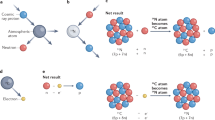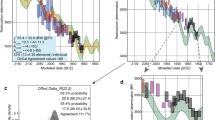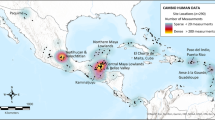Abstract
Arising from: P. Mellars Nature 439, 931–935 (2006); Mellars replies
The review by Mellars1 provides an archaeological perspective on some of the latest developments in radiocarbon dating of bone. However, his presentation, calibration and interpretation of radiocarbon ages are misleading in some cases, and important technical advances in the pretreatment of other sample types that have increased dating accuracy have been overlooked. These considerations may undermine the conclusions drawn about past human dispersals.
Similar content being viewed by others
Main
As Mellars points out1, ultrafiltration of bone samples can yield final age determinations that are significantly different from ages derived by traditional methods1,2. The latest results from ultrafiltration show that the ages originally reported from archaeological contexts should be considered as only minimum estimates. Although Mellars says that bones are the most widely available materials for dating1, most (75%) of the ages plotted in Fig. 3 of ref. 1 are based on charcoal (P. Mellars, personal communication). As with bone, important developments have taken place in the preparation of charcoal for radiocarbon dating. Advances in the pretreatment and graphitization of charcoal3 have extended its dating range to at least 55,000 yr before present (BP) and make it probable that many of the original age determinations for charcoal are minima. Unfortunately, Mellars reconstructs routes and rates of modern human dispersal across Eurasia from published ages of samples that had not been pretreated using the new methods.
Mellars also erroneously refers to NotCal04 (ref. 4) as a 'calibration'; however, NotCal04 is a summary of data sets that extend beyond the 26,000 calibrated years BP limit of the internationally accepted radiocarbon curve, IntCal04, and is not a calibration curve (hence the name4). The records that contribute to the NotCal04 comparison curve deviate by up to several millennia from one another5,6,7,8 (Fig. 1). Significant variability in atmospheric radiocarbon content is also indicated by a recently produced data set9. Some of this variability is due to uncertainties in the dating of individual records, but features common to all records will include, for example, short-lived excursions in the Earth's magnetic field8.
The graph shows the NotCal04 best-fit curve4, and Cariaco Basin sediments5, Lake Suigetsu varves6, the Bahamas speleothem7, and tropical Atlantic and Pacific corals9 radiocarbon data sets. Age ranges at 1σ uncertainty (including those for the NotCal04 curve) are plotted only on the 'radiocarbon years BP' axis.
Atmospheric 14C variability has not followed a simple, smooth pattern, as suggested by Mellars1. Instead, smoothing took place during the statistical analysis of these data sets to develop the NotCal04 mean best-fit line. By using the mid-point of the mean best-fit line, Mellars artificially improves the apparent precision of calibrated ages in his Fig. 3; even 'infinitely' old ages are reported with improved precision, whereas calibration almost invariably results in age ranges that are significantly larger than the radiocarbon measurement error10.
We appreciate that Mellars' review was restricted to radiocarbon dating, principally of bone, but it is recommended practice that multiple methods and materials should be investigated to avoid any possible pitfalls that might be associated with a single technique or sample type. Several numerical-age methods are now available for the dating of bone11, sediments and artefacts12 that complement one another and add much-needed rigour to radiocarbon chronologies. We recommend that the accepted nomenclature for ages should be strictly followed to avoid confusion13: radiocarbon ages should be reported as 'BP', time before present (where 'present' is AD 1950); calibrated ages as 'cal. yr BP'; and ages from alternative dating methods in calendar years.
Inevitably, researchers will need to compare finds older than 26,000 cal. yr BP to other records measured on calendar timescales. When ages are 'calibrated', it must be specified which curve has been used. Meanwhile, radiocarbon ages should be reported in their uncorrected form for recalculation when an accepted calibration curve is developed.
Only by taking these considerations into account can we hope to develop robust models for human dispersal.
References
Mellars, P. Nature 439, 931–935 (2006).
Higham, T. F. G., Jacobi, R. M. & Ramsey, C. B. Radiocarbon 48, 179–195 (2006).
Turney, C. S. M. et al. Quat. Res. 55, 3–13 (2001).
van der Plicht, J. et al. Radiocarbon 46, 1225–1238 (2004).
Hughen, K. et al. Science 303, 202–207 (2004).
Kitagawa, H. & van der Plicht, J. Radiocarbon 42, 369–380 (2000).
Beck, J. W. et al. Science 292, 2453–2458 (2001).
Voelker, A. H. L., Grootes, P. M., Nadeau, M.-J. & Sarnthein, M. Radiocarbon 42, 437–452 (2000).
Fairbanks, R. G. et al. Quat. Sci. Rev. 24, 1781–1796 (2005).
Guilderson, T. P., Reimer, P. J. & Brown, T. A. Science 307, 362–364 (2005).
Eggins, S. M. et al. Quat. Sci. Rev. 24, 2523–2538 (2005).
Roberts, R. G. Radiat. Meas. 27, 819–892 (1997).
Colman, S. M., Pierce, K. L. & Birkeland, P. W. Quat. Res. 28, 314–319 (1987).
Author information
Authors and Affiliations
Corresponding author
Rights and permissions
About this article
Cite this article
Turney, C., Roberts, R. & Jacobs, Z. Progress and pitfalls in radiocarbon dating. Nature 443, E3 (2006). https://doi.org/10.1038/nature05214
Published:
Issue Date:
DOI: https://doi.org/10.1038/nature05214
This article is cited by
-
Progress and pitfalls in radiocarbon dating (Reply)
Nature (2006)
Comments
By submitting a comment you agree to abide by our Terms and Community Guidelines. If you find something abusive or that does not comply with our terms or guidelines please flag it as inappropriate.




